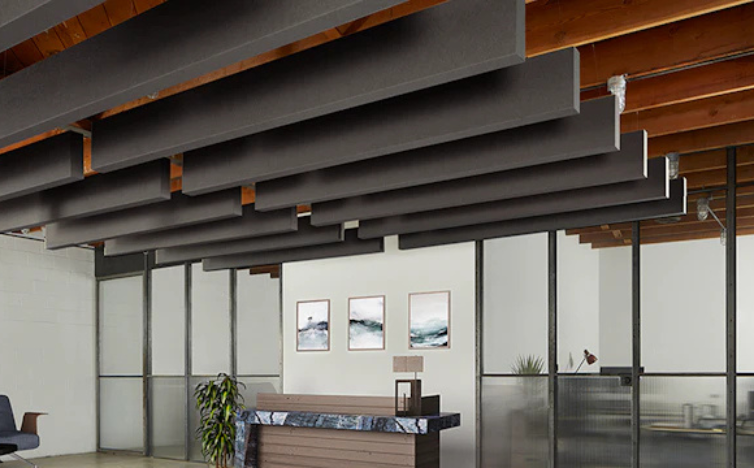Acoustic baffles are crucial for managing sound in spaces where noise reduction and aesthetic appeal are essential. However, deciding between vertical vs horizontal baffles can be challenging. This article breaks down the differences, benefits, and ideal applications of each type, helping you choose the best option for your unique environment.
Understanding Acoustic Baffles
Acoustic baffles are sound-absorbing panels that hang from ceilings, typically in larger spaces with high ceilings, like auditoriums, open offices, and restaurants. They are highly effective at minimizing noise and controlling echoes by disrupting sound waves as they move through a room. These baffles can be installed either vertically or horizontally, with each configuration offering unique benefits and aesthetic options.

What Are Vertical Baffles?
Vertical baffles are suspended perpendicular to the ceiling, usually as narrow, rectangular panels. They offer an open, spacious feel that can add dimension to a room without reducing the visual openness of the ceiling.
Benefits of Vertical Baffles
- Improved Sound Control: Vertical baffles effectively absorb sound in spaces where high ceilings contribute to noise issues. Their upright orientation disrupts sound waves as they move upwards, reducing echoes.
- Aesthetic Versatility: Vertical baffles offer a modern, sleek look that can add visual depth to any space.
- Maximized Airflow: Unlike certain horizontal baffles, vertical installations allow for unrestricted airflow, ideal in settings where ventilation is a concern.
Ideal Applications for Vertical Baffles
Vertical baffles are well-suited for environments where ceiling height needs to be preserved visually or where airflow is a concern. They are commonly used in:
- Open office layouts to control noise between workstations.
- Auditoriums and event halls for effective sound control without blocking lighting.
- Restaurants where the ceiling is part of the aesthetic appeal.
See also: Acoustic Baffles for Restaurants: Improve Ambience
What Are Horizontal Baffles?
Horizontal baffles are mounted parallel to the ceiling, creating a “cloud” effect. They offer a visually cohesive and expansive look, adding layers and structure to the ceiling.
Benefits of Horizontal Baffles
- Strong Acoustic Absorption: Due to their parallel positioning, horizontal baffles are effective at absorbing sound coming from multiple directions, ideal for spaces where reverberation is a significant concern.
- Enhanced Lighting Control: Horizontal baffles can also reduce glare and control lighting reflections, making them ideal for spaces where visual comfort is important.
- Design Customization: Horizontal baffles can be arranged in varied patterns and densities, allowing for creative ceiling designs and customized sound control.
Ideal Applications for Horizontal Baffles
Horizontal baffles work well in spaces where direct sound absorption from multiple directions is needed. They are often used in:
- Classrooms or lecture halls where speech clarity is essential.
- Conference rooms where audio clarity is needed for presentations.
- Retail spaces where noise levels need to be minimized while maintaining a clean aesthetic.
Comparing Vertical and Horizontal Baffles
Acoustic Performance
While both types effectively absorb sound, vertical baffles are especially useful in spaces with high ceilings and open airflow needs, while horizontal baffles provide enhanced control over multi-directional sound in enclosed or highly reverberant spaces.
Visual Impact
Vertical baffles create an open, dimensional feel without obscuring the ceiling, while horizontal baffles add layered structure and are often more visually pronounced.
Installation and Maintenance
Horizontal baffles typically require more precise placement for optimal effectiveness, while vertical baffles are easier to install due to fewer spatial restrictions. Both types offer easy maintenance, but cleaning may vary depending on placement and material.
See Also: Acoustic Baffles vs Ceiling Clouds: Choosing the Right one
Factors to Consider When Choosing Baffles
When deciding between vertical and horizontal baffles, consider the following factors:
- Purpose of the Space: For spaces like classrooms or offices where speech clarity is essential, horizontal baffles may be ideal. Vertical baffles work well in large, open areas with high ceilings.
- Ceiling Height and Design: Vertical baffles are often preferred in rooms with high ceilings as they enhance the sense of height, while horizontal baffles create a layered effect suitable for standard-height ceilings.
- Ventilation and Airflow: Vertical baffles are better for spaces where airflow must remain unobstructed, whereas horizontal baffles may impact ventilation slightly, depending on installation density.
Which Is Right for You?
Choosing between vertical and horizontal baffles largely depends on your space’s needs, aesthetic preferences, and acoustic goals. If you need sound control while preserving ceiling height and airflow, vertical baffles may be the ideal solution. If you’re looking for stronger sound absorption across a broader area and want to create a layered ceiling effect, horizontal baffles could be the better choice.
Call us: Contact DeSound Soundproofing Expert in Dubai For Soundproofing: +971 56 231 4204
Conclusion
Both vertical and horizontal baffles are excellent options for managing acoustics in spaces where noise control is crucial. By considering the unique requirements of your space—whether it’s an open office, classroom, or retail area—you can select the right type of baffle to enhance both the sound quality and aesthetic appeal of your environment.

